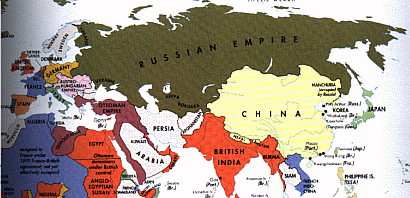
Communism first took hold in Russia, a nation with a centuries-old reputation for despotism, servility, and brutality. The Marquis de Custine, whose Letters from Russia (1839) led many to dub him "the de Tocqueville of Russia" observed that "Government in Russia is military discipline in the place of civil order, a state of siege which has become the normal state of society." This authoritarian tradition strongly influenced the Russian Marxists, and through them much of the world socialist movement. Some of the important features of czarism that Communism drew upon and intensified included:
Absolute Power
The histories of most of the nations of Europe are marked by multi-polar and limited centers of power. King, church, and nobles usually had to share power to a significant extent. As legal historian Harold Berman writes:
The pluralism of Western law, which has both reflected and reinforced the pluralism of Western political and economic life, has been, or once was, a source of development, or growth - legal growth as well as political and economic growth. It also has been, or once was, a source of freedom. A serf might run to the town court for protection against his master. A vassal might run to the king's court for protection against his lord. A cleric might run to the ecclesiastical court for protection against the king.
Law and Revolution
The Russian form of government is an absolute monarchy, tempered
by assassination. |
Russia, in contrast, was for centuries marked by the extraordinary concentration of power in the hand of a single man, the czar. Ivan III began the use of the term, a Russified version of "caesar." From the Byzantine Empire, the Russians acquired not only the Eastern Orthodox faith, but also a careful theoretical defense of absolute and undivided power.
 When one
of the czars went too far, dissidents normally had to submit or
turn to violent rebellion. Before 1917, the last truly significant
civil unrest ended in 1613, when the Romanov dynasty assumed the
throne. The Romanovs carefully cemented their nation's tradition
of total and autocratic power. Within a generation, the Romanovs
cast off the oversight of the nobility; Czar Peter the Great,
assuming power in 1696, tightened the monarchy's grip even further:
When one
of the czars went too far, dissidents normally had to submit or
turn to violent rebellion. Before 1917, the last truly significant
civil unrest ended in 1613, when the Romanov dynasty assumed the
throne. The Romanovs carefully cemented their nation's tradition
of total and autocratic power. Within a generation, the Romanovs
cast off the oversight of the nobility; Czar Peter the Great,
assuming power in 1696, tightened the monarchy's grip even further:
At the head of the state was the tsar or emperor, possessing absolute, unlimited powers. An ancient assembly, or Duma, of nobles, which had formerly exercised vague legislative rights, was practically abolished, its place taken by an advisory Council of State whose members, usually noblemen, were selected by the tsar. All traces of local self-government were similarly swept away, and the country was henceforth administered by the tsar's personal agents.
Carlton Hayes, A Political and Social History of Modern Europe
While the rest of Europe, under the influence of the Enlightenment, slowly moved to limit monarchical power and protect human rights, Russia's czars showed their determination to resist unwanted foreign influences. Catherine the Great, eager to improve her international reputation, postured as an "Enlightened monarch"; but as serfdom faded away in the rest of Europe, "...Catherine was extending the scope of serfdom. Her vast grants of crown estates to her officials and lovers clamped the fetters of bondage on a multitude of hitherto free crown peasants. Without opposition from Catherine, the nobility began to impose serfdom in newly annexed lands such as the Ukraine." (William Langer, Western Civilization)
 When
the French Revolution and its aftermath placed absolute monarchy
at risk all over Europe, the czars doggedly suppressed dissent.
As de Custine put it, "In Russia, despite their limitless
power, the rulers have an extreme fear of criticism, or even of
plain speaking." Opponents of the status quo risked banishment
to the harsh prison camps of Siberia. Only defeat in the Russo-Japanese
War in 1905 sufficed to pressure Czar Nicholas II to recognize
civil liberties and create an elected assembly to limit his power.
It appeared that Russia might finally be on the road toward modern
limited government, but by 1907 the czar had reneged on many of
his concessions. The czarist system overthrown in 1917 was not
as autocratic as that of Czar Peter or Czarina Catherine, but
it had resisted change like no other monarchy in Europe.
When
the French Revolution and its aftermath placed absolute monarchy
at risk all over Europe, the czars doggedly suppressed dissent.
As de Custine put it, "In Russia, despite their limitless
power, the rulers have an extreme fear of criticism, or even of
plain speaking." Opponents of the status quo risked banishment
to the harsh prison camps of Siberia. Only defeat in the Russo-Japanese
War in 1905 sufficed to pressure Czar Nicholas II to recognize
civil liberties and create an elected assembly to limit his power.
It appeared that Russia might finally be on the road toward modern
limited government, but by 1907 the czar had reneged on many of
his concessions. The czarist system overthrown in 1917 was not
as autocratic as that of Czar Peter or Czarina Catherine, but
it had resisted change like no other monarchy in Europe.
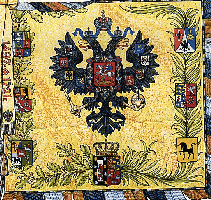
The Union of Church and State
In a word, what the Russian Church lacks is what is lacking
throughout this country: freedom, without which life fades and
light is extinguished. |
Only the western portion of the Roman Empire fell in 476 AD; the eastern half, known as Byzantium, endured for another millennium. This political division of Europe gave rise to a crucial religious difference. In the former western Roman Empire, the Catholic Church claimed and maintained some degree of independence from secular rulers.
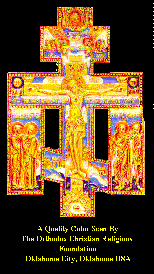
[Peter] deprived the patriarch of Moscow of his privilege of controlling the ecclesiastical organization and vested all powers of church government in a body, called the Holy Synod, whose members were bishops and whose chief was a layman, all chosen by the tsar himself. No appointment to ecclesiastical office could henceforth be made without the approval of the Holy Synod; no sermon could be preached and no book could be published unless it had received the sanction of that august body.
Carlton Hayes, A Political and Social History of Modern Europe
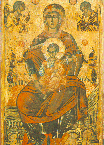 The czarist
state dominated the Orthodox Church, but by making its priests
into government employees, it won their loyalty and obedience.
With one swoop, the state cemented an alliance with Russia's intellectual
class. The intelligentsia thus were not independent critics of
the state, but its hired apologists; or as de Custine remarked,
"This Byzantine religion, emerging from a palace to establish
order in a military encampment, cannot fulfill the highest needs
of the human soul, but merely assists the police in deceiving
the people... Shephards who are slaves can only lead barren spirits:
an Orthodox priest will never teach is flock anything except to
bow to force."
The czarist
state dominated the Orthodox Church, but by making its priests
into government employees, it won their loyalty and obedience.
With one swoop, the state cemented an alliance with Russia's intellectual
class. The intelligentsia thus were not independent critics of
the state, but its hired apologists; or as de Custine remarked,
"This Byzantine religion, emerging from a palace to establish
order in a military encampment, cannot fulfill the highest needs
of the human soul, but merely assists the police in deceiving
the people... Shephards who are slaves can only lead barren spirits:
an Orthodox priest will never teach is flock anything except to
bow to force."
The czarist alliance of Church and State foreshadowed the Communist system in two crucial respects. The Communist state, like the czarist state, created a kept class of intellectual apologists to inculcate its rigid dogma; instead of priests, these were the Party theoreticians, lecturers, professors, journalists, and writers. And while the Communists initially waged war against all forms of religion, it did not take them long before they restored the priests of the Orthodox Church to the government's payroll and the government's service.
Servile Labor and Official Brutality
While the other nations of Europe were gradually abolishing serfdom, Catherine the Great was extending it in Russia. Serfdom and slavery still existed in Russia in 1839 when de Custine wrote his Letters, and was not officially abolished until 1861. Nor was this a marginal institution; servile labor was the norm, not the exception.
The living conditions of the slave and serf have varied enormously by place and time. In Russia, their treatment was especially harsh. "They were attached to the soil, that is, without their lord's consent they could not leave the estate on which they were born, and a transfer of an estate from one nobleman to another automatically transferred the peasants' allegiance. To their lord the peasants paid dues, for him they performed compulsory manual labor, to him they rendered obedience as to a personal master." (Carlton Hayes, A Political and Social History of Modern Europe) Catherine the Great permitted the owners of serfs to sell them to colonists in Siberia or equally harsh conditions.
The Third Census of the Russian Empire (1762-1766) provides us with the estimates of the extent of bondage; in all probability, fully seven-ninths of the Russia population was unfree at this time. Notably, at least 40% of these serfs and slaves were owned by the Russian state; (the percentage swelled after the state nationalized the land and serf holdings of the Orthodox Church). Serfdom and slavery did gradually decline in importance, but extremely slowly, as these additional censuses reveal:
|
Unfree Persons as a Percentage of the Population of Czarist
Russia
| ||
| Census Year | Private Serfs/Slaves | Government Serfs/Slaves |
| 1722 | 46% | 31% |
| 1796 | 54% | 40% |
| 1812 | 51% | 37% |
| 1835 | 36% | 35% |
| 1851 | 31% | 34% |
| 1859 | 29% | 35% |
Source: James Mavor, An Economic History of Russia, p.418. Note that in Mavor's tables, the number of bondsmen excludes women, while the total population counts both sexes. | ||
How did this condition of servitude originate?
The large number were the children of bonded parents, some became bonded through marriage, some through inscription on the poll tax rolls, with or without their own consent, some were captives taken in war, some were arrested rioters, who had been granted in bondage by way of punishment, some were Asiatic tribesmen... and some were State peasants, who had been transferred to private ownership along with lands or factories granted by the state.
James Mavor, An Economic History of Russia
"A ruler can be popular in Russia without attaching great value to the lives of Russians" noted de Custine. And while landlords might at least take care of their serfs to avoid losing a valuable investment, the Czars were rich enough to freely spend the lives they owned. The Winter Palace was destroyed by fire in 1837, but when de Custine arrived in 1839, it had already been rebuilt. How was this seemingly impossible feat accomplished? With the lives of a great many slaves:
Labour in the mines of the Urals would be less threatening to life, yet the Petersburg workers were not criminals. I have been told that those poor wretches who painted the halls where the heat was greatest were obliged to cover their heads with a kind of ice-cap, so that they could preserve the use of their senses in the baking heat they were forced to endure as long as the work continued... Yet the sovereign was called "Father" by all these men, sacrificed before his eyes in the sole name of imperial vanity.
The Marquis de Custine, Letters from Russia
Usually, when such events take place, the Tsar orders the
entire village to be deported to Siberia. This is what is known
in St. Petersburg as "populating Asia." |
Out of all of the barbarities of the Czarist state, the most horrific was its system of prison camps and "colonies" in Siberia. Some of the inhabitants were fur-trappers and government employees, who went more or less voluntarily but others were far less willing: "The third group consisted of war prisoners - Poles, Lithuanians, Ukrainians, Baltic Germans, Swedes, among others - ordinary criminals, and political and religious dissenters. These deportees, in order to survive, had no choice but to defend, protect, and expand Muscovy's interests. The fourth group... was made up of farmers, craftsmen, artisans, and priests, whom the authorities sent to Siberia to assist the trailblazers." (James Mavor, An Economic History of Russia) Siberia was run like a vast military camp, or one vast prison.
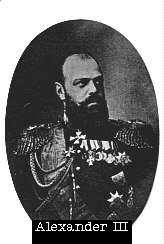 "Siberia"
is virtually a synonym for a dire threat hung over the heads of
dissenters. In 1914, about 9 million people lived in Siberia,
of whom around 1 million were prisoners or deportees. Siberia
came to house many of Russia's greatest novelists. Revolutionary
opponents of the Czar were also likely to have suffered years
of imprisonment in Siberia. Lenin, Stalin, and Trotsky all spent
time in Siberian exile. The lesson they learned was not that sentencing
their political enemies to arctic prison camps was wrong, but
that they should make sure that their enemies never Siberia alive.
"Siberia"
is virtually a synonym for a dire threat hung over the heads of
dissenters. In 1914, about 9 million people lived in Siberia,
of whom around 1 million were prisoners or deportees. Siberia
came to house many of Russia's greatest novelists. Revolutionary
opponents of the Czar were also likely to have suffered years
of imprisonment in Siberia. Lenin, Stalin, and Trotsky all spent
time in Siberian exile. The lesson they learned was not that sentencing
their political enemies to arctic prison camps was wrong, but
that they should make sure that their enemies never Siberia alive.
Statist Economic Policy
Communism made the economic role of the Soviet state greater than ever before in history, but statist economic policy in Russia hardly began in 1917. Government in Russia always played a leading role in the economy, and in no European country were the ideas of laissez-faire less influential. Adam Smith found a few followers, such as Storch and Turgueniev, who advocated free trade and the abolition of serfdom; but they were outside the mainstream of Russian economic thought.
By far the most significant economic role of the Russian state stemmed from its actual ownership of millions of serfs and the land upon which they toiled. Until the abolition of serfdom in 1861, the Czar owned over one-third of the population (the map below indicates the level of serfdom one year prior to the 1861 decree).
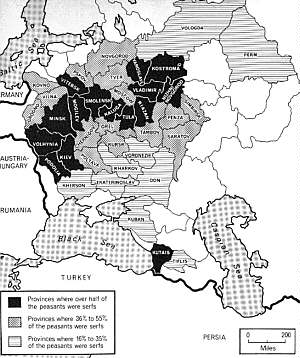
In other cases, the Czars would subsidize industrialization by giving businessmen some slave laborers: "For trifling amounts large works with all their appurtenances, including villages of ascribed peasants, were handed over to these favourites of the Court." (James Mavor, An Economic History of Russia) The Czars carefully graded their followers by rank, giving each successive level power and authority over their inferiors. The Russia economy was thus a perfect example of mercantilism, the incestuous alliance between government and legally privileged business interests.
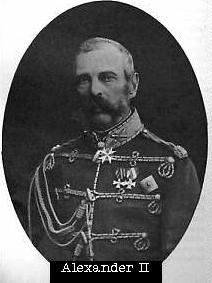 The czarist
government's role in the Russian economy took many other forms.
It's role in the labor market shrunk dramatically with the abolition
of serfdom under Alexander II. But other areas of the economy
found themselves coming under tighter government regulation and
intervention.
The czarist
government's role in the Russian economy took many other forms.
It's role in the labor market shrunk dramatically with the abolition
of serfdom under Alexander II. But other areas of the economy
found themselves coming under tighter government regulation and
intervention.
- Protectionism.
Peter the Great set up a 75% tariff on imports to protect "infant industries" and raise additional revenue. While tariffs were cut back in the aftermath of the French Revolution, by the mid 19th-century protection was back in fashion. Serge de Witte, minister of finance from 1893-1903, led the war against foreign imports: "By 1894, under Witte's guidance, Russia had become a thoroughly protectionist country... Protection of manufacturers and great landlords, however, cost the poor peasant and the workingman very dearly: it was demonstrated in 1905 that the retail price of cotton and sugar was two and one-half times as great in Russia as in Germany, that of iron four and one-half times as great, and that of coal six times as great." (Carlton Hayes, A Political and Social History of Modern Europe)
- Industrial Policy.
When Peter came to the throne there were no large factories in Russia; when he died there were 233 State and private factories and foundries. These establishments were either founded by the State and managed by State officials, or they were subsidized by the State.
(James Mavor, An Economic History of Russia)
The Russia state owned and subsidized numerous industries from the time of Peter the Great onwards. The natural extension of this policy in the second half of the nineteenth century was for the Russian government to begin building government-owned railroads, such as the famous Trans-Siberian Railroad. The government also bought privately owned railroads when they proved unprofitable, ran a system of state banks, and much more.
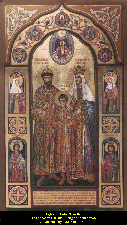
- State Monopolies.
Peter the Great set up numerous government monopolies. Resin, potash, rhubarb, glue, salt, tobacco, vodka, chalk, tar, fish, cards, dice, and even coffins were made the exclusive province of government production. The monopolized commodities' prices were generally set at two to four times their prices under free competition. Witte continued this monopolistic tradition by making the entire liquor industry a state monopoly, and nationalizing private liquor shops.
- High taxes.
Peter the Great found building a "modern state," with modern armies and navies, to be an expensive proposition. Aside from monetary debasement (the "inflation tax"), excises were levied on stamps, rents, beehives, beards, mustaches, private bathhouses, and marriage licenses, and many other goods. Religious dissenters had to pay a special tax; so did the unbaptized. Worst of all was the "soul tax" levied upon every male person; this tax, which did not even exist in 1701, made up over 50% of the government budget by 1724. The profligate tendencies of the czarist state continued throughout its subsequent history.
- Factory and Social Legislation.
While modernizers like Witte tried to state-manage industrialization, agricultural interests struggled to stifle it. But in the end Witte had his way: in the late 1800's industrialization was taking off in Russia. This gave the Russian government a new area to regulate: the employee- capitalist relationship. Bismark-style factory laws regulating working conditions, hours, and child labor were passed. (Notably, the St. Petersburg capitalists were usually for stricter regulation, while the Moscow employers opposed it; the St. Petersburg capitalists probably foresaw that such laws would be a good check upon competition). Witte's administration made government regulation stricter. "Government officials were to mediate in all labor disputes. Mines regulations were instituted, and plans for insurance of all workmen against accidents were prepared." (Carlton Hayes, A Political and Social History of Modern Europe)
Imperialism and Great Russian Nationalism
The Anglo-American relies upon personal interest to accomplish
his ends and gives free scope to the unguided strength and common
sense of the people; the Russian centers all the authority of
society in a single arm. The principal instrument of the former
is freedom; of the latter, servitude. Their starting-point is
different and their courses are not the same; yet each of them
seems marked out by the will of Heaven to sway the destinies of
half the globe. |
Czarist Russia is often not even mentioned as one of the great imperialist powers of Europe. The difference is that British, French, and German imperialists founded overseas empires, while the Czars simply began annexing adjacent lands. Its wars in Europe with Sweden, the Ottoman Empire, and Poland gave the Czars relatively little - but densely populated - territory. The centuries-long war against bordering indigenous peoples gave the Czars few new subjects, but an enormous land area stretching all of the way to Alaska.
Russia's conquest of the primitive peoples of Siberia and Asia was in many ways similar to the Indian wars of the United States. Siberian tribes of Ostiaks, Samoeds, Nenets, Tungus, Mongols, Iakuts, Iukagirs, Chukchis, Koriats, and Kamchadals all fell under Russian domination. Russian rule was frequently brutal, and deadly. To take but one example, out of about 30,000 native Aleuts who lived in Alaska prior to Russian conquest, a scant 3,000 remained when Alaska was sold to the United States in 1867.
The Czar's earliest conquests passed almost unnoticed: the Ukrainians and so-called "White Russians" (not to be confused with the pro-czarist forces during the Russian Civil War), although under Russian domination for centuries, were distinct ethnicities who struggled fiercely to retain their culture and way of life. Further west, Poles, Balts, Finns, and numerous other peoples fell under Russian rule. Poland and Finland both enjoyed considerable autonomy, but even light-handed Russian administration seemed harsh to peoples unaccustomed to it. During the 1800's, other small nations were forced to submit: Georgians, Chechens, Armenians, and numerous others. Mongolia and northern areas of China were added to the Czars' impressive portfolio of conquests.
Russian imperialism was already a difficult burden for subject peoples to bear, but it became worse whenever the urge to "Russify" them caught the Czar's ear. Particularly under the rule of Alexander III, minorities within the Russian Empire found that their native language and religion were under official attack. Poles, Jews, Finns, Muslims and other groups found their religions persecuted, their schools forced to teach solely in Russian, their marriages denied legal recognition, and worse. Jews in particular suffered from official economic discrimination and semi- official violence known as pogroms.
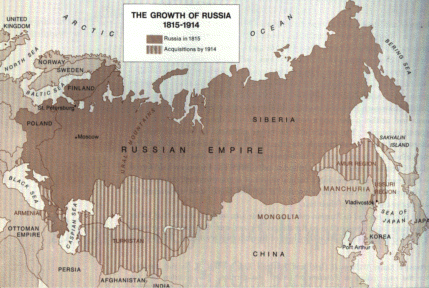
The great irony of history is that Russian imperialism was often overlooked simply because Russians did not have to board ships to conquer Asia. Russian imperialism was on par with, and often far worse than, British or French imperialism. Even the collapse of the Soviet Union has left a substantial portion of the Russian Empire intact, for while many subject peoples won their independence, others - such as the Chechens - still live under Russian domination.
